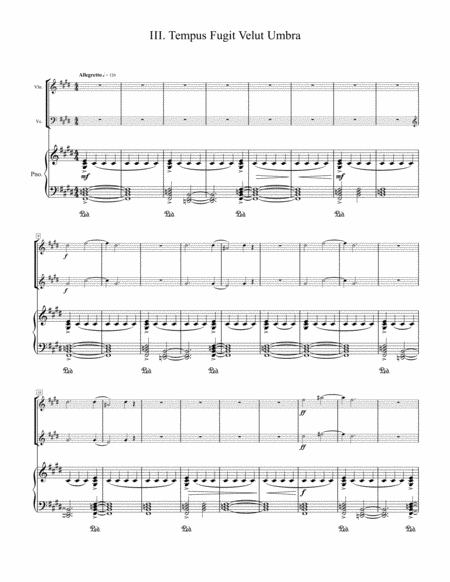Piano Trio,String Ensemble - Digital Download SKU: A0.1004151 Composed by Matthew Scott Phillips. 20th Century,Contemporary. Score and parts. 9 pages. Matthew Scott Phillips #3510887. Published by Matthew Scott Phillips (A0.1004151). Throughout the centuries, sundials (a flat plate that marks the time of the day by the shadow of a gnomon which is cast onto it) have been used by civilizations to tell time. Unlike modern clocks and digital watches, in which every single second has its own momentary significance, telling time by sundial is more evolutionary. The seconds, and hours, melt into one another. It is perhaps for this reason that sundials have often been conceived not only as practical time pieces, but as works of art, metaphors, and creations that are inherent expressions of the personality of their creators. Etched in many sundials across the world, in Latin, English, German, and other languages are often found mottoes that reflect the thoughts of the sundial's creator. These mottoes can be fatalistic, humorous, transient, morbid, or serene, and almost always involve the subjects of time, the passing of the hours, life and its brevity, or metaphors involving shadows. Many times these mottoes feature some witticism, such as I only count the sunny hours (since a shadow must be present for a sundial to function). Other times, they can be revealingly existential (We are but shadow), and other times offer advice (Use the hours, don't count them).It is these statements of philosophy, etched in sundials throughout the centuries, that most interests me. I am currently composing a set of movements for piano trio (Piano, Violin, Cello) dedicated to the mottoes found on sundials, and their significance to me. The first movement, subtitled Tempus Edax Rerum (Time devours things) is expansive and attempts a feeling of eternity, into which all seemingly fast moving workings of human beings are inevitably subsumed. For the second movement I am considering the phrase Pereunt et Imputantur (They pass and are counted referring to the hours of the day), and its implication of the way in which time can slip away, whether we observe it or not.
